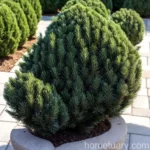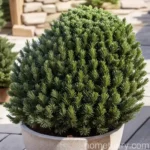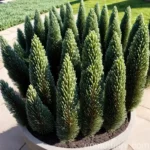Norway Spruce (Picea abies ‘Little Gem’)
Norway spruce, scientifically known as Picea abies ‘Little Gem’, is a magnificent evergreen tree that is native to Europe. This tree is prized for its elegant beauty, adaptable nature, and various landscape uses. In this comprehensive guide, we will explore the key characteristics and requirements to cultivate and care for the Norway spruce, focusing specifically on the ‘Little Gem’ variety. We will delve into its cultural significance, uses, ideal environmental conditions, maintenance practices, diseases, pests, and propagation methods. By the end of this article, you will have a profound understanding of this remarkable tree, equipped with the knowledge to cultivate and appreciate it to the fullest.
Key Takeaways
Before delving into the intricacies of cultivating a Norway spruce ‘Little Gem’, let’s grasp the primary aspects highlighted in this article:
- Plant Name: Norway Spruce (Picea abies ‘Little Gem’)
- Uses: Ornamental and landscape purposes
- Water: Moderate water requirements
- Sunlight: Partial to full sunlight
- Fertilizer: Balanced fertilizer in spring
- Soil: Well-draining, acidic soil
- Pruning: Prune for shaping and maintenance
- Propagation: By seeds or cuttings
- Container: Suitable as a container plant
- Common Diseases: Canker, Needlecast, Rust
- Common Pests: Spider mites, Spruce gall aphids
What is Plant: Norway Spruce (Picea abies ‘Little Gem’)?
Norway spruce, scientifically known as Picea abies, is a species of evergreen coniferous tree in the family Pinaceae. The ‘Little Gem’ variety is a compact and ornamental selection of the Norway spruce, known for its symmetrical growth and delightful presence in gardens and landscapes. With its dense foliage and elegant form, it adds a touch of natural elegance to any setting. Now, let’s delve into the various aspects of caring for and utilizing the Norway spruce ‘Little Gem’.
Culture
Uses
The Norway spruce ‘Little Gem’ holds various cultural and practical uses, primarily as an ornamental tree due to its elegant appearance and versatility in landscaping. Its lush green foliage provides an attractive backdrop and serves as an excellent specimen tree in gardens, parks, and larger landscapes. Additionally, the compact size of the ‘Little Gem’ variety makes it particularly well-suited for smaller gardens or restricted spaces, where it can be utilized as a focal point or as a component of a mixed border.
Water
This evergreen tree has moderate water needs, particularly during its initial establishment period. However, once established, it exhibits good drought tolerance. Adequate watering is crucial, especially during dry spells, to ensure its healthy growth and appearance. It is important to avoid overwatering, as this can lead to root rot and other related issues.
Sunlight
Norway spruce ‘Little Gem’ thrives best in partial to full sunlight. It requires at least six hours of sunlight per day to promote healthy growth and maintain its dense foliage. When planted in a location with insufficient sunlight, it may become sparse and less vibrant. Therefore, it is vital to select a suitable location that receives ample sunlight for optimal performance.
Fertilizer
Providing the Norway spruce ‘Little Gem’ with a balanced fertilizer in early spring before the initiation of new growth can significantly enhance its vigor and overall health. A slow-release fertilizer formulated for evergreen trees can work effectively, providing the necessary nutrients for robust growth and dense foliage.
Soil
The ‘Little Gem’ variety thrives in well-draining acidic soils, replicating its native forest environment. It is essential to ensure proper soil drainage to prevent waterlogging, which can lead to root damage. A slightly acidic soil with a pH range between 5.5 and 6.5 is ideal for promoting optimal growth and nutrient uptake.
Pruning
Pruning is an essential aspect of maintaining the attractive form and structure of the Norway spruce ‘Little Gem’. Regular pruning helps in shaping the tree, eliminating dead or damaged branches, and enhancing air circulation within the canopy. It is advisable to conduct pruning during the dormant season to minimize stress on the tree and promote healthy regrowth. Care should be taken to avoid excessive pruning, as it may lead to sparse foliage and a less compact appearance.
Propagation
The propagation of Norway spruce ‘Little Gem’ can be achieved through both seeds and cuttings. However, propagation via seeds may take longer to produce viable trees, while propagation through stem cuttings allows for the reproduction of genetically identical trees with the desired traits. For successful propagation through cuttings, it is essential to use healthy and disease-free plant material, employ proper rooting hormones, and provide optimal environmental conditions to facilitate root development.
Container Popularity
The compact nature and aesthetic appeal of the ‘Little Gem’ variety make it well-suited for container cultivation. It serves as an excellent option for adorning patios, decks, and other outdoor living spaces with its evergreen charm. When grown in containers, it is crucial to ensure adequate drainage and provide regular care, including watering and fertilization, to support its growth and maintain its ornamental value.
Common Diseases
Norway spruce ‘Little Gem’ is susceptible to various diseases that can affect its appearance and overall health. Some common diseases that may impact this tree include canker, needlecast, and rust. Regular monitoring for signs of diseases, prompt intervention, and proper cultural practices, such as providing adequate airflow and maintaining optimal soil moisture, can aid in preventing and managing these diseases effectively.
Disease Diagnosis
Diagnosing diseases affecting the Norway spruce ‘Little Gem’ requires careful observation of the tree’s foliage, branches, and overall vigor. Symptoms such as browning or discoloration of needles, presence of lesions or cankers on branches, and premature needle shedding can indicate potential disease issues. Seeking assistance from a professional arborist or plant pathologist can aid in accurate disease diagnosis and formulation of an effective management plan.
Common Pests
In addition to diseases, the ‘Little Gem’ variety may also be susceptible to certain pests that can adversely impact its health and appearance. Common pests include spider mites and spruce gall aphids, which can cause visible damage to the foliage and stems. Regular inspection of the tree, early pest detection, and implementation of appropriate control measures, such as horticultural oils or insecticidal soaps, can help in mitigating pest infestations effectively.
Botanist’s Tips
1. Environmental Compatibility
When selecting a location for planting Norway spruce ‘Little Gem’, ensure that it is compatible with the environmental conditions of your region, including temperature, soil type, and sunlight exposure. This consideration is essential to promote the long-term health and vitality of the tree.
2. Regular Maintenance
Engage in regular maintenance practices, including watering, fertilization, and pruning, to preserve the aesthetic appeal and overall vigor of the ‘Little Gem’ variety. Consistent care plays a pivotal role in sustaining the tree’s health and resilience to environmental stressors.
Fun Facts
- The Norway spruce is a historically significant tree, known for its utilization as a Christmas tree in various cultures due to its elegant form and dense foliage.
- Norway spruce forests serve as vital habitats for diverse wildlife species, providing food, shelter, and nesting sites for numerous organisms.
- The wood of the Norway spruce is valued for its versatility and is used in the construction of musical instruments, particularly soundboards for pianos and violins.
- In its native habitat, the Norway spruce can achieve impressive heights, with some specimens reaching over 60 meters in height.
Links to External Resources
To supplement the information provided in this article, here are some valuable external resources that offer additional insights into the cultivation, care, and preservation of the Norway spruce ‘Little Gem’:
- Royal Horticultural Society – Picea abies ‘Little Gem’ (Norway Spruce)
- Missouri Botanical Garden – Picea abies ‘Little Gem’ Norway Spruce
- The Spruce – Norway Spruce Tree Profile
In conclusion, the Norway spruce ‘Little Gem’ stands as a remarkable tree, revered for its ornamental value, adaptability, and ecological significance. By understanding its cultural needs, ideal growth conditions, and maintenance practices, you can cultivate and cherish this evergreen beauty in various landscapes and garden settings. Whether as a focal point in a garden or as a container specimen adorning a patio, the ‘Little Gem’ variety embodies the timeless allure and enduring presence of the Norway spruce. Embracing its charm and vitality enhances the natural richness of any environment, while also fostering an appreciation for the intrinsic beauty of this resilient and captivating coniferous tree.
As you embark on the journey of cultivating and nurturing the Norway spruce ‘Little Gem’, may the insights shared in this guide empower you to foster its flourishing growth and revel in its evergreen elegance.
Remember, the Norway spruce ‘Little Gem’ is not merely a tree; it is a magnificent embodiment of resilience, natural grace, and enduring allure.
Thank you for exploring the remarkable world of the Norway spruce ‘Little Gem’ with us!















